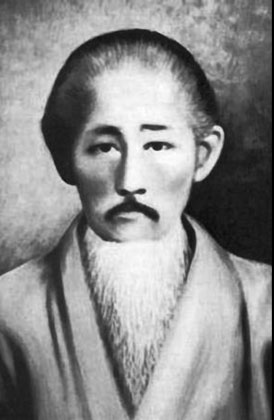 Kanryo Higaonna was born on March 10, 1853, in Naha, the capital city of Okinawa. Higaonna began his martial arts training in 1867 from Aragaki Seisho. In 1870 at the age of 16 he traveled to Fuzhou, China. Higaonna studied from a Chinese named Wei Shinzan. Wei was the student of Ryu Ru Ko who also taught Higaona so-called Fukien Crane Chang. Fukien Crane was a combined school with White Crane of South Shaolin Chang and Four Ancestor Chang.
Kanryo Higaonna was born on March 10, 1853, in Naha, the capital city of Okinawa. Higaonna began his martial arts training in 1867 from Aragaki Seisho. In 1870 at the age of 16 he traveled to Fuzhou, China. Higaonna studied from a Chinese named Wei Shinzan. Wei was the student of Ryu Ru Ko who also taught Higaona so-called Fukien Crane Chang. Fukien Crane was a combined school with White Crane of South Shaolin Chang and Four Ancestor Chang.
In China, there were two counter parted arts of Chang, or fist. One is categorized as hard style, or External style. The other is Soft style or Internal style. Hard and External style represent Zen Buddhist initiated school such as various branches of Shao-lin Chun, and Soft and Internal style represent Yee Chuen, Pai Kua Chang, and Tai Chi Chuen.
The Chinese system of fist that Kanryo Higaonna studied from Wei Shinzan and Ryu Ru Ko was also known by its name Pan Gainoon, which literally means, “one half is hard and other half is soft”. Those kata practiced in the current Goju-Ryu school like Sanchin, Sanseiru, and Pecchurin all originated from that style. Higaonna also received instruction from numerous other gongfu masters including Wai Xinxian.
In the year 1881, he returned to Okinawa where his martial arts would become known as Naha-te. Kanryo Higaonna taught martial arts to the people of Okinawa and at the same time continued his own research and practice. In October 1905 Higaonna began teaching at the Naha Commercial High School. There are many stories that relate tales of Kanryo Higaonna’s life and training. The power of his legs was legendary so that often he was referred to as “Ashi no Higaonna”, (“legs Higaonna”) in Okinawa. Kanryo Higaonna’s name is synonymous with Okinawan martial arts and Naha-te.
Kanryo Higaonna died in 1915 at the age of 63